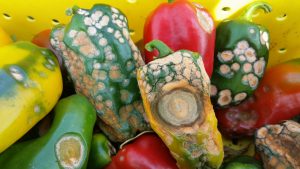Copper resistance in bacterial leaf spot of tomato and pepper crops has been detected at a high level in New Jersey the past few summers. While not surprising, copper resistance has been known to develop for decades now. Copper applications for the control of bacterial diseases in many crops has been a mainstay for decades now and is often applied in weekly protectant fungicide programs. With help from Dr. Nrupali Patel and Dr. Don Kobayashi, bacteriologists in the Department of Plant Biology located on the New Brunswick campus, a (NJ-VGA funded) survey was initiated to determine which species of bacterial leaf spot are most prevalent in New Jersey tomato and pepper crops. Bacterial leaf spot can be caused by four species of Xanthomonas: X. euvesicatoria, X. vesicatoria, X. perforans, and X. gardneri. Currently, there are four races of BLS found in tomato (T1-T4; one for each of the 4 species stated above) and eleven races found in pepper (0-10). Differential tests in southern New Jersey using various bell pepper lines over the past 15 years has suggested that the number of races of BLS in pepper has increased over time; with all races present in the State to date. Lab testing results from samples collected from the small number of NJ vegetable farms the last three summers has shown the presence of X. euvesicatoria in pepper, as well as X. euvesicatoria and X. perforans in both tomato and pepper in the state, with ~60% of all samples testing positive for copper resistance.
Bacterial leaf spot, copper resistance, hot water seed treatment, and viruses
Preparing for Pepper Anthracnose in 2025

Pepper Anthracnose
Pepper anthracnose caused by Colletotrichum spp. has become a significant problem on some farms in southern New Jersey.
Unlike in tomato, where symptoms are only present in mature (red) fruit, pepper anthracnose can infect pepper fruit at any growth stage. Currently, there are no commercially-available bell or non-bell peppers with known resistance to anthracnose. [Read more…]
Cucurbit powdery mildew control in 2025
Cucurbit powdery mildew (CPM), caused by Podosphaera xanthii, is one the most important diseases of cucurbit crops throughout the world. The pathogen is an obligate parasite, just like cucurbit downy mildew, meaning it needs a living host in order to survive. In northern regions that have a killing frost in the fall the pathogen will die out when the crop freezes. Not being able to overwinter, the pathogen must be re-introduced each spring or summer in the mid-Atlantic region. The pathogen accomplishes this by re-infecting cucurbit crops in the spring as they are planted up the east coast starting in Florida, then the Carolina’s, Virginia, and so forth. By late May, as soon as cucurbit crops begin to germinate in the mid-Atlantic region, the potential threat for potential powdery mildew infections begin. [Read more…]
Tobacco Streak Virus (TSV) found on tomato in New Jersey
Tobacco Streak Virus (TSV) was found on fresh-market tomato this past week in southern New Jersey. TSV has a host range of close to 200 species, including cranberry, tobacco, tomato, pepper, asparagus, bean, soybean, mustard, radish, a number of ornamental hosts as well as weeds such as thistle, field bindweed, and jimson weed. Like Tomato Spotted Wilt Virus (TSWV), the Tobacco Streak Virus is also vectored by thrips. TSV can be seed-borne (reported in some hosts), spread via pollen, and mechanically transmitted. Symptoms can vary significantly depending on the host. Infected plants may have downward leaf curling, show black streaks on leaves and stems, chlorosis, stunted growth, deformed growing tips, ring spots, and flower drop. There is no genetic resistance to TSV in tomato and management should focus on keeping thrips populations as low as possible, scouting on a regular, removing infected plants, and knowing your weed population (as a potential source). The only method to correctly identify TSV is through serological tests such as ELISA.
For more information on Tomato Spotted Wilt Virus please click here.
Vegetable Disease Update – 7/3/25
Collar rot on fresh-market tomato has been reported sporadically around the state over the past week. For more information please click here.
White mold and Southern blight have been reported this past week on fresh-market tomato in both high tunnels and fields in southern New Jersey.
Cucurbit downy mildew was reported in MI this past week. There have been no reports of CDM in the region to date.
Wet weather brings on the development of Phytophthora blight.
Preparing for Pepper anthracnose this growing season.
Tomato Spotted Wilt Virus (TSWV) has been reported in southern New Jersey. For more information please click here.

